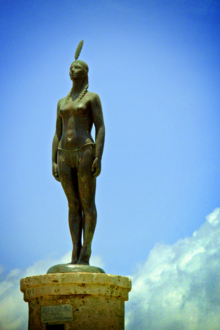| Catalina | |
|---|---|
 Statue of India Catalina in Cartagena de Indias. Statue of India Catalina in Cartagena de Indias. | |
| Born | c. 1495 |
| Died | May 11 1538, Cartagena de Indias. |
| Occupation(s) | Translator, interpreter |
| Known for | Translator for Pedro de Heredia during the Spanish conquest of the Chibchan Nations. |
| Spouse | Alonso Montañez |
India Catalina (1495- May 11, 1538) was an indigenous child of Mokaná ethnicity from the Colombian Atlantic coast, who was kidnapped by Pedro de Heredia to be an interpreter and intermediary, playing a role in the Spanish conquest of Colombia.
History
Catalina, the daughter of a local chief, was abducted in 1509 by Spanish conquistador Diego de Nicuesa from an indigenous settlement known as Zamba o Galerazamba in the department of Bolívar. She was sent to Santo Domingo, where she learned the Spanish language and adopted the Catholic Christian faith, although she was still considered a slave. She served as an interpreter to the Native Americans under Pedro de Heredia during his conquest of Colombia. She was also his concubine for many years, but after she took him to court for stealing gold, it is possible that Pedro had her married to his nephew Alonso Montañez. She died in Cartagena de Indias on May 11, 1538.
The name "india (the indian) Catalina" appeared in a letter sent for Pedro de Heredia to King Carlos V in 1533. Her indigenous name was never mentioned in the documents.
According to the Colombian drama series "La reina de Indias y el conquistador" (The Queen and the Conqueror), her indigenous names are Katalydeyewua and Kaitegua.
Monument

The monument to India Catalina was sculpted by Eladio Gil Zambrana and presented to the public in 1974. Small scale replicas are used in the Cartagena Film Festival awards.
See also
References
- Archivo General de Indias. Probanza de Álvaro de Torres, Alguacil del Cartagena. Santa Fe, 80, N. 10 A, fol. (41 r) 2.
- De Castellanos, Juan. Historia de Cartagena, op. cit., p. 22.
- Simón, Pedro, Fray, op. cit., Tomo V, Capítulo XIII, p. 73.
- Urbina Joiro Hernán. Entre las huellas de la india Catalina. Bogotá. Universidad del Rosario, 2017, p. 80.
- Fernández de Oviedo, Gonzalo. Natural y General Historia de las Indias, op. cit., Vol. 3, p. 144.
- Archivo General de Indias. Información tomada por el obispo. Declara Juan Alonso Palomino, criado del gobernador Pedro de Heredia, el 22 de noviembre de 1535. Justicia, fol. 33r.
- Archivo General de Indias. Declaración de Juan Alonso Palomino, criado del Gobernador Pedro de Heredia. Justicia, 522.
- Archivo General de Indias. Primera declaración de la india Catalina contra Pedro de Heredia en primer juicio de residencia en Cartagena. Justicia, 521, Fol. 169R a Fol.170.
- Archivo General de Indias. Segunda declaración de la india Catalina contra Pedro de Heredia en primer juicio de residencia en Cartagena. Justicia, Justicia 522, Fol.191V a Fol.192.
- Urbina Joiro Hernán. Entre las huellas de la india Catalina. Bogotá. Universidad del Rosario, 2017, p. 80.
- Urbina Joiro, Hernán. Entrevista a Víctor Nieto. Cartagena. 2004. En: Entre las huellas de la india Catalina, Universidad del Rosario, 2017, p. 124.
- Lecturas: Fin de Semana El Tiempo newspaper, pag. 2, Vicente Martinez Emilliani, September 9, 2006
- Dr. Luis Fernando Villanueva
- BIOGRAFÍAS DE HOMBRES ILUSTRES Ó NOTABLES, Relativas á la época del Descubrimiento, Conquista y Colonización de la parte de América denominada actualmente Estados Unidos de Colombia. Doña Soledad Acosta De Samper, 1883
External links
- Places of interest in Cartagena
- Wikimedia Commons has a multimedia category named India Catalina.
- 1490s births
- 1500s missing person cases
- 1529 deaths
- Indigenous peoples in Colombia
- 16th-century Colombian people
- Spanish colonization of the Americas
- Monuments and memorials in Colombia
- Colombian women
- Converts to Roman Catholicism from pagan religions
- Women in war in Colombia
- Buildings and structures in Cartagena, Colombia
- Monuments of Colombia
- Kidnapped Colombian people
- People from Bolívar Department
- Women in 16th-century warfare
- 16th-century translators
- 16th-century slaves
- 16th-century indigenous people of the Americas
- 16th-century indigenous women of the Americas